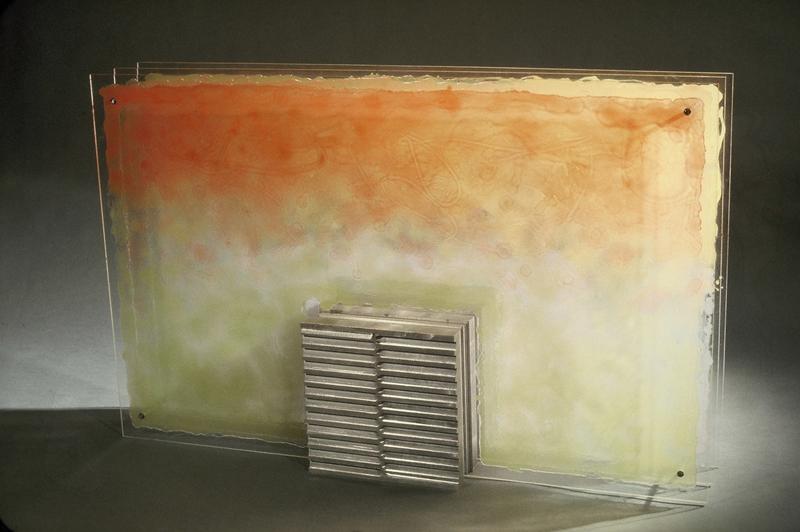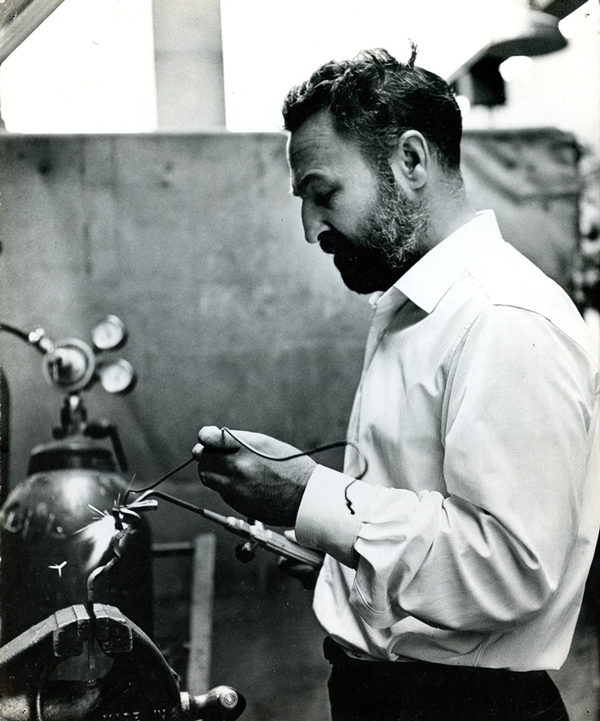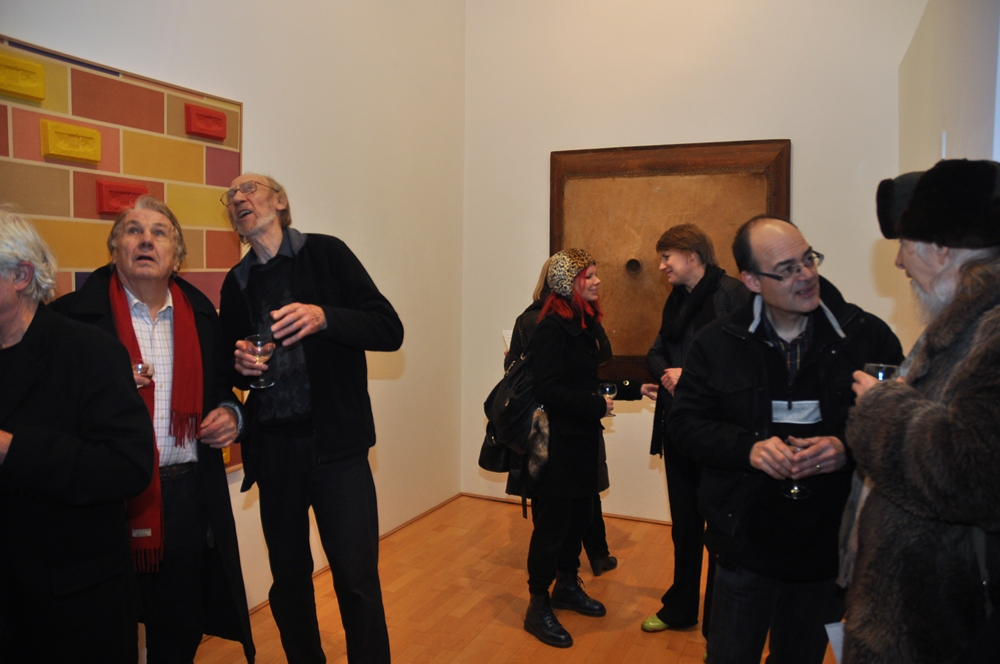The Excruciating Power of the Parental Legacy: My First Foray Into Curating | reviews, news & interviews
The Excruciating Power of the Parental Legacy: My First Foray Into Curating
The Excruciating Power of the Parental Legacy: My First Foray Into Curating
Mark Hudson's first exhibition had a subject close to home: his father

Remember when you were out playing football with your mates, and your dad pulled up beside the pitch in a slightly too flashy car and told you it was time for tea or – even worse – tried to join in the game – and how you died inside. Actually, I don’t remember this Nick Hornbyesque scenario, having spent most of my childhood avoiding playing football, but I certainly recognise the sentiment.
No matter how much we love our parents, no matter how much we want to think well of them, even to feel proud of them, they inevitably cramp our style. And they keep on doing it from beyond the grave.
Our parents inevitably cramp our style. And they keep on doing it from beyond the grave
My father was an artist. No, that doesn’t make me feel proud. Those words have on occasion made me feel almost physically sick. My father was a larger-than-life working class hero who carved out a niche for himself in the history of Post-War British art. He was one of the people who modernised British art education, throwing out antique casts in favour of machines and new materials, creating an emphasis on problem-solving rather than learning time-honoured crafts.
 As a child I was greatly impressed by him, believed everything he said unquestioningly; in adolescence and early adulthood, I spent much of my time trying to get as far away from him as possible. He was too forthright, too unyielding, too loud in his opinions. By the time I went to art school myself, in the mid-1970s, his brand of utopian Modernism was so out of fashion I found it hard to imagine it had ever existed. When I went for an interview at the college where I eventually did my degree, the Head of Printmaking said, "We had Edward Bawden ’s son here. His work was exactly like his father’s. Yours is nothing like your dad’s." I glowed with pride. My portfolio might have been downright pitiful, but at least it had nothing to do with HIM.
As a child I was greatly impressed by him, believed everything he said unquestioningly; in adolescence and early adulthood, I spent much of my time trying to get as far away from him as possible. He was too forthright, too unyielding, too loud in his opinions. By the time I went to art school myself, in the mid-1970s, his brand of utopian Modernism was so out of fashion I found it hard to imagine it had ever existed. When I went for an interview at the college where I eventually did my degree, the Head of Printmaking said, "We had Edward Bawden ’s son here. His work was exactly like his father’s. Yours is nothing like your dad’s." I glowed with pride. My portfolio might have been downright pitiful, but at least it had nothing to do with HIM.
How then did I come to find myself curating an exhibition of my father and his associates’ work?
When he died in 1997, I found myself taking stock – as people tend to on such occasions. Having spent most of the previous three decades trying to outdo him – fulfilling my creative potential in a way I felt he hadn’t quite fulfilled his, and making quite a good job of it, I thought – I now had to face the fact that whatever one might think of his historical role, at least he had one. It was one of those moments – quite gratifying at the time – when the son realises that the father is bigger than him.
Looking through my father’s papers at the National Art Education Archive, I found vast numbers of slides, films and photographs that would make the basis of a fantastic exhibition. But was I going to organise it? Was I hell? With the revival of interest in Modernist design, his structural reliefs, that had long looked merely cranky, now appeared almost trendy. I’d thought he’d blown his chances as an artist by spending too much time teaching, but with the rise of multi-disciplinary art, the idea of the artist-as-teacher and teacher-as artist felt very current. But I couldn’t afford to spend time promoting his legacy when I needed to create one of my own.
Then last autumn, my sister was clearing her cellar prior to moving, and found a piece of our father’s work. As soon as I pulled the sheet of plastic from the fibreglass relief I was transported straight back to 1965, when my father had assembled a group of young turk artists to realise his educational ideas, and we were living the Modernist dream in a house my father had co-designed on the beach near Cardiff. It was a moment when my childhood sense that everything was for the best in the best of all possible worlds happened to coincide with the high water mark of heroic Post-War optimism: a faith in technology and the future that was reflected in the bright colours and polished surfaces of my father’s work.
Rubbing off the decades of grime I saw that the brilliant blue and green surfaces still gleamed. It occurred to me that we could get a few other pieces of work together in a room, open a bottle of wine, and we’d have a modest little exhibition.
I went to see Michael Richardson, whose excellent Art Space Gallery in Islington has given shows to two of the artists my father worked with – Michael Sandle and Terry Setch. I went into that meeting with a vague idea about exhibiting a few bits of familial stuff. I came out the curator of an exhibition. I had no idea what I’d let myself in for.
 An exhibition has to have a coherent raison d’etre, a point to make, a story to tell, that will allow it to compete with all the hundreds, even thousands, of other exhibitions taking place in London alone at any one time. Michael and I hit on an idea relatively easily: centred on a photograph of my father and his colleagues in the so-called Leicester Group (left). Him and six younger artists, who all taught together at Leicester College of Art, looking young and bolshie. This we decided was an “iconic” image that represented a “moment” the world needed to know about: which would be all about the interaction of art and education in the heady Sixties.
An exhibition has to have a coherent raison d’etre, a point to make, a story to tell, that will allow it to compete with all the hundreds, even thousands, of other exhibitions taking place in London alone at any one time. Michael and I hit on an idea relatively easily: centred on a photograph of my father and his colleagues in the so-called Leicester Group (left). Him and six younger artists, who all taught together at Leicester College of Art, looking young and bolshie. This we decided was an “iconic” image that represented a “moment” the world needed to know about: which would be all about the interaction of art and education in the heady Sixties.
At first it was all good fun: persuading the surviving artists that it was worth being involved, getting together a body of work that would back up our thesis – and though it wasn’t yet 50 years ago, large amounts of work had been lost, particularly my father’s. Far from laughing in our faces, “people that mattered” were very encouraging. Yet the more it began to feel like a real exhibition, the more I was beset by a sense of visceral embarrassment at the idea of exposing my father – and myself alongside him.
I’d imagined some “expert” would write the catalogue essay, but of course it fell to me – there were no experts on this forgotten corner of British art history. Writing it took longer, per word, than anything I’ve ever written: trying to make it compelling without making one claim that was even slightly exaggerated. There was I felt a lot riding on this. If the show was a failure it would be an appalling embarrassment; if it was a success the implications were potentially even more onerous: I like to present myself as a maverick who owes nothing to anybody. Now in middle age, there was a chance I would be seen simply as the son of someone slightly well known.

By now some of the heavy hitters of the art world were coming out of the woodwork. “I didn’t realise Tom Hudson was your father,” said one. “That is major, major stuff.” But of course I had always suspected that.
As I walked towards the private view I realised that with the mad rush to get the exhibition installed, and my anxious ambivalence, I had failed to adequately publicise it. And now, of course, it was too late.
- Transition or The Inner Image Revisited is at Art Space Gallery, 84 St Peters Street, London N1 until 2 March.
Explore topics
Share this article
Add comment
The future of Arts Journalism
You can stop theartsdesk.com closing!
We urgently need financing to survive. Our fundraising drive has thus far raised £49,000 but we need to reach £100,000 or we will be forced to close. Please contribute here: https://gofund.me/c3f6033d
And if you can forward this information to anyone who might assist, we’d be grateful.

Subscribe to theartsdesk.com
Thank you for continuing to read our work on theartsdesk.com. For unlimited access to every article in its entirety, including our archive of more than 15,000 pieces, we're asking for £5 per month or £40 per year. We feel it's a very good deal, and hope you do too.
To take a subscription now simply click here.
And if you're looking for that extra gift for a friend or family member, why not treat them to a theartsdesk.com gift subscription?
more Visual arts
 'We are bowled over!' Thank you for your messages of love and support
Much-appreciated words of commendation from readers and the cultural community
'We are bowled over!' Thank you for your messages of love and support
Much-appreciated words of commendation from readers and the cultural community
 Folkestone Triennial 2025 - landscape, seascape, art lovers' escape
Locally rooted festival brings home many but not all global concerns
Folkestone Triennial 2025 - landscape, seascape, art lovers' escape
Locally rooted festival brings home many but not all global concerns
 Sir Brian Clarke (1953-2025) - a personal tribute
Remembering an artist with a gift for the transcendent
Sir Brian Clarke (1953-2025) - a personal tribute
Remembering an artist with a gift for the transcendent
 Emily Kam Kngwarray, Tate Modern review - glimpses of another world
Pictures that are an affirmation of belonging
Emily Kam Kngwarray, Tate Modern review - glimpses of another world
Pictures that are an affirmation of belonging
 Kiefer / Van Gogh, Royal Academy review - a pairing of opposites
Small scale intensity meets large scale melodrama
Kiefer / Van Gogh, Royal Academy review - a pairing of opposites
Small scale intensity meets large scale melodrama
 Jenny Saville: The Anatomy of Painting, National Portrait Gallery review - a protégé losing her way
A brilliant painter in search of a worthwhile subject
Jenny Saville: The Anatomy of Painting, National Portrait Gallery review - a protégé losing her way
A brilliant painter in search of a worthwhile subject
 Abstract Erotic, Courtauld Gallery review - sculpture that is sensuous, funny and subversive
Testing the boundaries of good taste, and winning
Abstract Erotic, Courtauld Gallery review - sculpture that is sensuous, funny and subversive
Testing the boundaries of good taste, and winning
 Edward Burra, Tate Britain review - watercolour made mainstream
Social satire with a nasty bite
Edward Burra, Tate Britain review - watercolour made mainstream
Social satire with a nasty bite
 Ithell Colquhoun, Tate Britain review - revelations of a weird and wonderful world
Emanations from the unconscious
Ithell Colquhoun, Tate Britain review - revelations of a weird and wonderful world
Emanations from the unconscious
 Rachel Jones: Gated Canyons, Dulwich Picture Gallery review - teeth with a real bite
Mouths have never looked so good
Rachel Jones: Gated Canyons, Dulwich Picture Gallery review - teeth with a real bite
Mouths have never looked so good
 Yoshitomo Nara, Hayward Gallery review - sickeningly cute kids
How to make millions out of kitsch
Yoshitomo Nara, Hayward Gallery review - sickeningly cute kids
How to make millions out of kitsch
 Hamad Butt: Apprehensions, Whitechapel Gallery review - cool, calm and potentially lethal
The YBA who didn’t have time to become a household name
Hamad Butt: Apprehensions, Whitechapel Gallery review - cool, calm and potentially lethal
The YBA who didn’t have time to become a household name

Comments
What a pleasure to find this